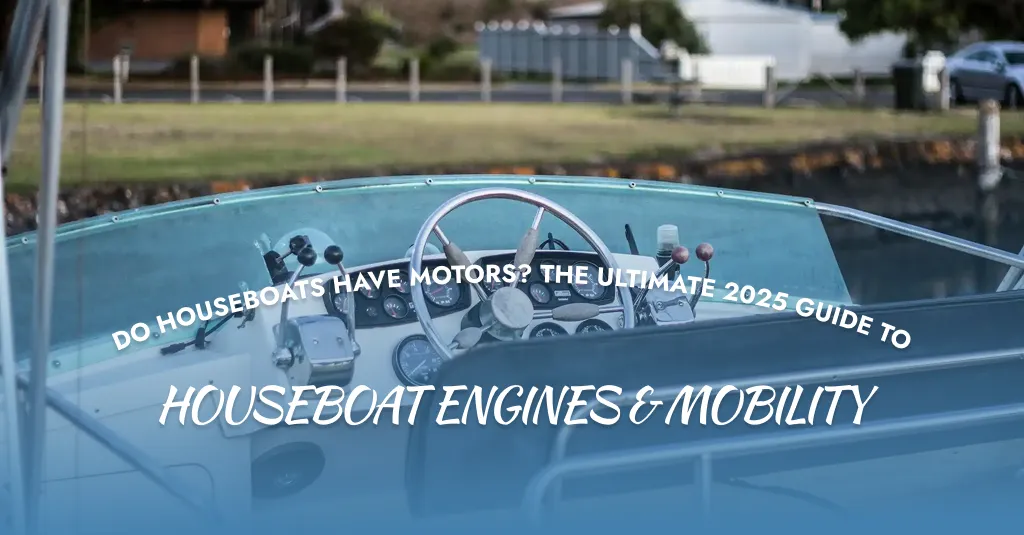
Do Houseboats Have Motors? The Ultimate 2025 Guide to Houseboat Engines & Mobility
The idea of drifting peacefully along a calm river or anchoring out in a quiet bay on your floating home is the dream of many water-lovers. But if you’re just starting your research, you might be wondering: do houseboats have motors?
It’s a great question, and an important one if you plan to move your houseboat from place to place or just want to understand how they work.
In this comprehensive 2025 guide, we’ll break down everything you need to know about do houseboats have motors, how they move, what types of engines they use, fuel considerations, maintenance tips, and whether all houseboats even need engines at all.
By the end, you’ll know exactly what powers these floating homes and which type of setup might be right for you.
Do Houseboats Have Motors? The Short Answer
Yes many houseboats do have motors. But not all of them do!
Whether a houseboat has a motor depends on its purpose and location. Some are fully motorized and designed for cruising. Others are stationary floating homes that never move from their dock or mooring so they don’t need an engine at all.
Why Do Some Houseboats Have Motors?
The main reason for having a motor on a houseboat is mobility. A motorized houseboat lets you:
-
Cruise lakes, rivers, or calm coastal waters.
-
Relocate to different marinas or mooring fields.
-
Find better fishing or swimming spots.
-
Escape storms or crowded anchorages.
In places like the Florida Keys, Lake Powell, or the Mississippi River, houseboats often double as vacation cruisers. In these spots, people want the freedom to move, so a working motor is essential.
Why Some Houseboats Don’t Have Motors
So, do houseboats have motors if they’re permanently docked? Not necessarily.
Stationary houseboats, sometimes called float homes, stay tied up to a dock year-round. These floating homes have plumbing, electricity, and sewer connections just like a house but no need for an engine.
Cities like Seattle, Sausalito, and Vancouver have large communities of non-motorized houseboats that never leave their slips. If the goal is to live on the water without moving, an engine would just be extra cost and maintenance.
Types of Houseboat Motors
When people ask, do houseboats have motors, they usually want to know what kind of motors they have.
Most motorized houseboats use either:
- Outboard Motors
- Inboard Engines
Let’s break these down.
Outboard Motors for Houseboats
Outboard motors are the most common propulsion system for smaller houseboats and older models.
What’s an Outboard Motor?
-
The engine, gearbox, and propeller are all one unit mounted on the back of the boat.
-
Easily removed or replaced.
-
Popular for pontoon-style houseboats.
Pros of Outboard Motors:
-
Simpler and cheaper to maintain.
-
Easy to upgrade to a bigger or more efficient model.
-
Frees up interior space.
Cons:
-
Not as powerful for larger houseboats.
-
Can be noisy.
-
Exposed to the elements.
Common Outboard Brands for Houseboats: Mercury, Yamaha, Honda.
Inboard Motors for Houseboats
Larger motorized houseboats usually have an inboard engine built into the hull.
What’s an Inboard Motor?
-
The engine is mounted inside the hull.
-
A propeller shaft runs from the motor through the hull to a propeller below the waterline.
Pros of Inboard Motors:
-
More power for bigger boats.
-
Quieter and better balanced.
-
Protected from weather.
Cons:
-
More complex to repair.
-
Takes up interior space.
-
Typically costs more to service.
Do Houseboats Have Motors Powerful Enough for Long Trips?
It depends! Houseboats are not speedboats they’re floating homes designed for calm waters and leisurely cruising.
Typical Speed:
Most houseboats with motors cruise at 5–10 knots (6–12 mph). They’re built for comfort, not speed.
Range:
With full fuel tanks, some houseboats can travel 100–200 miles, depending on the size of the engine, fuel capacity, and weather.
For longer trips, you’d plan for fuel stops and weather windows. River houseboats often follow calm inland waterways instead of rough open seas.
How Do Houseboats Get Fuel?
If you’re asking do houseboats have motors, the next question is: where do they get fuel?
Motorized houseboats usually run on:
-
Gasoline (most common for outboards)
-
Diesel (common for larger inboard engines)
You’ll refuel at marina fuel docks, similar to how you’d gas up a car, but with a few boat-specific precautions to avoid spills.
How Often Do You Need to Use the Motor?
Some houseboat owners only fire up their engines a few times a year to reposition for storms or move to a new slip.
Others, especially rental houseboats on lakes and rivers, use the engine daily to cruise from cove to cove.
In general, the more you cruise, the more you’ll need to budget for fuel, oil changes, and routine engine maintenance.
Houseboat Propulsion Alternatives
While most modern motorized houseboats use conventional gas or diesel engines, some owners are experimenting with:
Electric Motors: A few newer houseboats use electric propulsion for short, silent cruises powered by battery banks and solar panels.
Hybrid Systems: Combining electric motors with small diesel engines for range.
Towing: In rare cases, a stationary houseboat may be moved by tug if it needs to change marinas or undergo repairs.
Do Houseboats Have Motors You Can Upgrade?
Yes! Many people ask, do houseboats have motors that can be upgraded?
Absolutely. Upgrading your outboard motor is common for more power or better fuel efficiency. Switching from an old two-stroke to a modern four-stroke can dramatically improve fuel economy and reduce noise.
Inboard engines can also be swapped or rebuilt, but it’s more complex and costly. Some older houseboats have converted from inboard to outboard setups for simplicity.
Motor Maintenance: Keeping Your Houseboat Moving
If you own a motorized houseboat, regular maintenance is crucial.
Basic tasks include:
-
Oil and filter changes.
-
Checking fuel lines for leaks.
-
Inspecting the propeller.
-
Winterizing the engine if you’re in a cold climate.
-
Running the motor regularly to prevent issues.
How Do Houseboats Steer?
Another common question related to do houseboats have motors is: How do they steer?
Motorized houseboats steer using:
-
A steering wheel linked to the outboard or inboard rudder.
-
Throttle controls for speed.
-
Some modern boats add bow thrusters for better maneuvering in tight spaces.
While they’re generally easy to pilot, large houseboats can handle like a barge slow turns and wide swing radius!
What About Non-Motorized Houseboats?
Non-motorized houseboats or floating homes have no propulsion at all. They rely on:
-
Mooring lines and pilings to stay in place.
-
Local marinas for water, power, and sewage hookup.
If they ever need to move, they’re towed by another vessel.
These floating homes are popular where space is tight and people want the charm of water living without ever leaving the dock.
Should You Buy a Houseboat With or Without a Motor?
Here’s what to consider:
Get a Motorized Houseboat if You:
-
Want to cruise lakes or rivers.
-
Plan to move seasonally.
-
Need to reposition for storms.
-
Enjoy exploring different spots.
Stick With a Stationary Houseboat if You:
-
Want a floating home with zero hassle.
-
Will live in a marina full-time.
-
Prefer lower insurance and maintenance costs.
-
Don’t care about cruising.
Where Are Motorized Houseboats Most Popular?
Some of the most famous spots for motorized houseboats include:
-
Lake Powell (Arizona/Utah)
-
Lake Cumberland (Kentucky)
-
Florida Keys
-
Mississippi River
-
Lake Shasta (California)
In these places, cruising is half the fun. Rental fleets are usually fully motorized, so guests can explore hidden coves.
Insurance & Registration: Do Motors Make a Difference?
When people ask, do houseboats have motors, they often overlook the insurance part.
Yes having a motor affects your insurance premium.
Motorized houseboats:
-
Must be registered as a vessel.
-
Need liability coverage for operation.
-
Often cost more to insure than stationary float homes.
The Future: Electric & Solar Houseboats
One exciting answer to do houseboats have motors is emerging: electric propulsion.
As battery technology improves, some eco-friendly builders are designing houseboats with:
-
Solar panels charging lithium batteries.
-
Electric motors for short trips.
-
Quiet, emission-free cruising.
It’s still niche but a glimpse of a cleaner, quieter houseboat future.
So, next time someone asks you do houseboats have motors, you’ll know exactly how to answer!
Whether you’re planning a vacation on a motorized cruiser or dreaming of living full-time on a peaceful float home, understanding how your houseboat moves or doesn’t is key to a smooth life on the water.
Frequently Asked Questions (FAQs)
Do all houseboats have engines?
No only houseboats designed for cruising have motors. Many floating homes are stationary.
What type of motor does a houseboat use?
Most use outboard motors or inboard engines gas or diesel.
How fast can a motorized houseboat go?
Typically 5–10 knots (6–12 mph). They’re designed for comfort, not speed.
Can you remove the motor from a houseboat?
You can remove or replace an outboard. Removing an inboard is more involved.
Can you add a motor to a non-motorized houseboat?
Sometimes, yes but it depends on the hull design, weight, and local laws.





